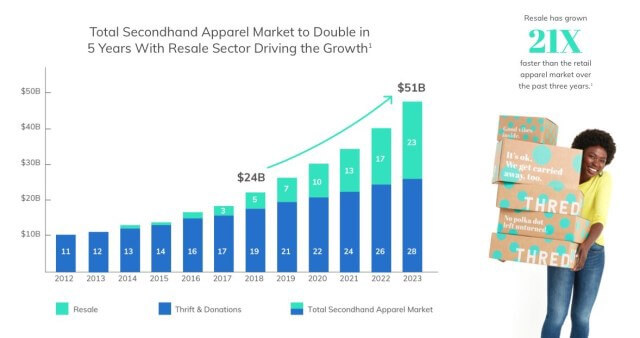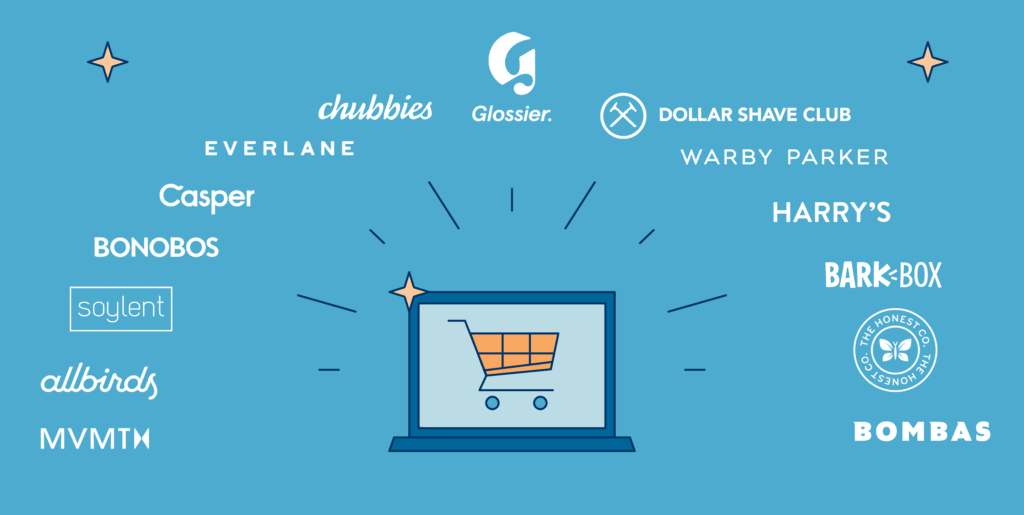Today’s ecommerce landscape is growing more competitive by the minute. As consumer expectations’ rise, so do the number of channels, their popularity, and the number of businesses using those channels. Simply put, ecommerce is crowded and businesses need to do more to stand out.
Running ad campaigns, maintaining a presence across channels, and delivering high-quality product content are all important. But they’re also things that your competition is probably also doing. So what else is out there? How can today’s brands and manufacturers go above and beyond their competition?
In this article, we’re going to look at three ideas for how modern businesses can go the extra mile and gain a competitive edge amongst the heavy competition. We’ll cover:
So without further ado, let’s dive in.
Leverage resale and secondhand marketplaces
If you can think of it, there’s probably a marketplace for it. Marketplaces are one of the most diverse channel types in ecommerce. There are big players like Amazon and eBay, but there are also those that cater to niche and regional audiences like Baidu and Naver. On top of that, there are resale marketplaces, which are a key player in the growing secondhand industry. However, despite being popular amongst their own audiences, “recommerce” sites aren’t often considered as key channels for today’s brands and manufacturers. Which means they tend to be less competitive, while still bringing in notable results for their sellers.
Resale marketplaces attract Gen Z and Millenials
The resale market is booming, a trend that is almost entirely driven by Gen Z and Millenials. In fact, the $24 billion industry is expected to reach $51 billion in value by 2023.

Why is it so popular?
- Most of today’s consumers __don’t mind if a product is used__ as long as it’s still in good condition.
- Buying pre-owned products is __cost-effective__ and a large portion of online shoppers are constantly on the hunt for the best price.
- It’s a __sustainable__ solution that consumers can have direct control over. Today’s buyers are becoming more and more aware of the impact their purchases have on the environment. Buying used and recycled products go in line with their lifestyle.
- Consumers want to be unique. Buying from a secondhand marketplace gives them the chance to __find products that they might not find anywhere else__. There is a growing trend in wanting to stand out and express yourself by what you wear and which products you use.
What resale marketplaces already exist?
One of the biggest verticals in the resale industry is fashion. There are a ton of marketplaces out there that already have substantial sized audiences and that fashion brands might want to consider.
| __StockX__ | Sneaker resale marketplace | Adidas, Nike, Converse, Gucci, Prada |
| __The RealReal__ | Luxury online consignment store | Chanel, Hermès and Louis Vuitton |
| __Poshmark__ | Fashion resale site | Nike, Michael Kors, Coach |
But the secondhand industry isn’t only for fashion brands, there are also some popular sites out there for used and refurbished electronics, auto parts, furniture, and more.
| __Newegg__ | Consumer electronics reseller | Dell, Lenovo, Dyson |
| __MPB__ | Used camera equipment | Canon, Nikon, Olympus, Fujifilm |
What types of products can be sold in the resale market?
Nothing is set in stone for what you can and can’t sell on secondhand marketplaces. It often depends on the channel, the condition of the product, and the type of product. Oftentimes the products don’t even need to be used! In fact, most brands and manufacturers have found that the following product types bring the best returns in resale.
- __Returned products:__ All too often businesses write off product returns as losses, which definitely does not have to be the case! Products that have been returned and/or had their packing opened are perfect contenders for the secondhand market.
- __Overstocked products:__ Your warehouse is full of products left unordered or maybe you had a glitch in manufacturing operations and were left with more stock than expected? It doesn’t have to go to waste. List leftover stock on a resale or discounted marketplace.
- __Seasonal products:__ It’s January, but your warehouse is full of leftover swimsuits from the summer season? Put them on discount on a fashion resale site.
- __Out-dated product lines:__ List those sneakers you still have in stock from 5 years ago.
Adopt a direct-to-consumer (D2C) sales model
It’s no doubt an interesting time to be a manufacturer. While traditional manufacturing sales relied on resellers, physical retailers, and wholesale buyers, the digitization and the rise of online shopping has changed the game. Just look at brands like Dollar Shave Club and Casper. These digital-native brands have seen great success by doing D2C from the start.

Now, consumers want the best online experience possible when shopping online. And they expect brands and product manufacturers to provide them with it. According to a study, 52% of consumers go straight to a brand’s website when searching for a product. So if you haven’t already, it’s time to start considering a D2C sales model for your business.
Benefits of selling D2C
So you understand that digitalization has changed the ecommerce landscape. But you’re busy with so many other projects, is D2C really worth your time? It might be! Take a look at just a few of the benefits it could bring.
- __Stronger customer relationships__
Today’s consumers want to feel recognized and to be given a personalized experience. As traditional manufacturing operations don’t deal directly with the customer, it’s long been difficult for manufacturers to develop a relationship with their end customers. D2C models allow businesses to gain valuable audience, behavior, and performance insights - just like a reseller would get. In fact, according to a Forrester report, 82% of manufacturers have seen improved customer relationships since initiating D2C sales models.
- __Faster time to market__
It can take months to years to introduce a new product to the market. By cutting out the middleman and selling directly to the consumer, businesses can drastically speed up the time it takes to launch products and increase the regularity of their product launches.
- __More opportunity to test__
Instead of mass-producing products that haven’t yet been ordered by your B2B buyers, why not test new products out in the market first to see how it performs. Not only can D2C testing provide you with valuable insights, but it can also entice more resellers to purchase and increase your number of POs. Forrester reports that 14% of manufacturers test out new products before making it available to retailers.
Selling products directly to consumers gives you the chance to make your brand’s voice heard. It’s your chance to tell the product’s real story since you know it best. In fact, more than 50% of manufacturers say that D2C sales have helped them improve brand awareness and increase sales.
Digitize your B2B sales strategy
At the heart of any manufacturing business lies a B2B sales strategy. All too often, however, the modernization of this strategy is overlooked and labeled as a low priority - which can be a costly mistake. In 2019, the B2B ecommerce market reached a value of 12.2 trillion USD - more than six times that of the B2C market. Let’s look at how B2B is changing before we get into what you can do to modernize your strategy.
Understanding the modern B2B buyer
Did you know that 73% of today’s B2B buyers are digital natives? These buyers are far different than the last generation. They grew up with technology and are used to being able to find whatever they want, wherever they are online. This characteristic can also be seen in B2B purchasing habits.
Forrester’s Bruce Eppinger, a senior analyst for digital business, found that 68% of buyers would rather find product content themselves rather than interacting with a sales rep. Remember, your B2B buyers are the same people who order dish soap via Alexa and live through Amazon Prime. So what can you do to modernize your approach to B2B sales and capture the attention of today’s buyers? Here are some ideas.
How to modernize your B2B sales strategy
Ensuring your B2B sales strategy is “digital-native-friendly” can carry many benefits if done right. Here are some ways to modernize your approach and capture the attention of today’s B2B buyers.
Offer a self-service buying option
Remember, your B2B buyers are the same people who order dish soap via Alexa and furniture through Amazon Prime. So offering a self-service model may be the way to go. The Productsup Content Portal, for example, allows your resellers to browse through your product offerings in a digital product portfolio. Here, they can download product pages at their own pace.
Add Amazon Business to your channel strategy
Ecommerce marketplace giant, Amazon, has become a key player in B2B ecommerce. Amazon Business, its B2B marketplace, is already used by 55 of Fortune 100 companies in the US. Due to its already established presence and reputation, leveraging this channel can be an easy way to reach new customers through digitization.
“Through the years, from being a traditional business to seeing the ever-changing economy and global landscape of business, Tensator was looking for ways to expand our customer reach as we move into the digital platform. We saw the opportunity with Amazon Business to take control of our brand and reach new customers through one channel."
David Cohen, Tensator
Optimize the information in your product catalogs
Today’s B2B and B2C consumers share the same appreciation for complete, up-to-date, and consistent product information. Ensure your product catalogs are complete with high-resolution images and videos, detailed product descriptions, and accurate product information. If buyers come across contradicting information elsewhere, they may be less inclined to move forward with a purchase.
Automate product catalog creation & distribution
Create online product catalogs tailored to the unique needs of each of your resellers. Since many buyer’s work with their own software to browse through and purchase products, make sure to deliver each catalog in the right format and file type for easy ingestion.
--
What works for one business, won’t always work for another. To stay competitive in today’s digital world, companies need to test, test, and then test some more.

![[WP Import] From D2C to recommerce, how brands and manufacturers can compete](http://images.ctfassets.net/q17uls4wkkdz/5JG29jxOYaEAoFcRgEJNdr/c33a22db4d7921daf1073ead78625950/20-01-16_From_D2C_to_resale_how_brands_can_stay_competitive_Ft_image_800x500.png?w=1200&h=675&fit=FILL)